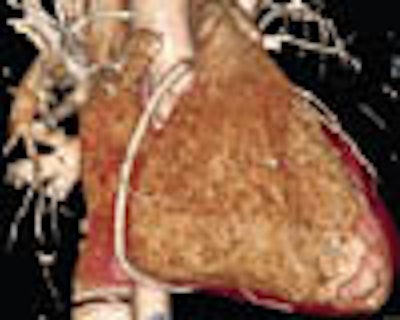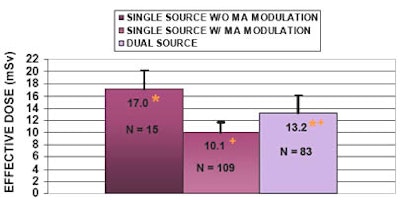
The introduction of dual-source CT imaging into clinical practice has the imaging community abuzz over its performance and potential -- particularly in the heart, the body's toughest imaging target. Early results have been positive, and sharp cardiac images are routinely acquired without the aid of beta-blockers.
One source of disagreement, imbued with a whiff of marketing hyperbole, is the radiation dose. In that realm, how does single-source 64-slice CT stack up against Somatom Definition (Siemens Medical Solutions, Malvern, PA), which uses two x-ray sources and two detectors at the same time? Once you double the temporal resolution, speed, and power, what happens to the dose?
"Over the past year, I've had conversations with many individuals regarding the radiation doses with dual-source CT," said Sandra Halliburton, Ph.D., in a talk at the 2006 RSNA meeting in Chicago. "It seems that people are often in one of two camps: one side who believes that dual-source requires half the radiation dose of single-source CT, and others who believe that dual-source CT requires twice the radiation dose of single-source. Most of the people thinking dual-source yields half the radiation dose are Siemens' salespeople, while most of the people who think dual-source CT requires twice the radiation dose are from these other vendors" (GE, Toshiba, Philips).
Which side is correct? Well, neither, according to a preliminary study at a single institution. Halliburton, along with her colleagues Stacie Kuzmiak and Dr. Paul Schoenhagen at the Cleveland Clinic Foundation's Cardiovascular Imaging (CVI) Core Laboratory in Ohio, sought to clarify the effective dose and give dual-source a run for its money against a 64-slice single-source machine, Somatom Sensation 64, also by Siemens.
Some elements of dual-source scanning could certainly increase the radiation dose, Halliburton said. For example, the second x-ray tube offers increased power when additional output is needed, but at the cost of higher dose. On the other hand, the company has included a second cardiac bow-tie filter, which removes x-rays from the periphery and tends to reduce dose.
Also, "in the single-source system, the acquisition parameters and reconstruction technique depend on multisegment reconstruction to achieve high temporal resolution -- this requires a slower pitch at most heart rates," she said. But there is no such requirement for dual-source, which uses single-segment reconstruction, and pitch that increases with the heart rate.
The heftier power reserves of dual-source mean that tube current modulation, also adapted to heart rate, can be active throughout the cardiac cycle -- even in the presence of cardiac arrhythmia, when single-source CT's dose modulation must be turned off to ensure adequate image quality, and the mAs run at full tilt throughout the cardiac cycle.
The researchers evaluated 517 patients divided into two clinically similar groups with equivalent average heart rates on either dual-source CT (n = 236) or single-source (n = 281) 64-slice CT. The patients were examined for a range of indications including coronary artery disease (CAD), coronary anomalies, bypass grafts, cardiac mass, pulmonary vein stenosis (PVS), pericardial disease, arrhythmogenic right ventricular dysplasia (ARVD), congenital heart disease, and thoracic aortic and thoracoabdominal aortic disease.
The effective dose was estimated from the dose-length product (DLP) [effective dose (mSv) = DLP (mGy x cm) x 0.017 (mSv/mGy/cm)]. This method was used in the European guidelines on quality criteria for CT published in 2000, Halliburton noted.
A higher mAs per rotation was selected, on average, for patients imaged on dual-source CT for CAD, coronary anomaly, and cardiac mass indications.
"We chose those values to take advantage of the higher power reserves of dual-source for larger patients," Halliburton told AuntMinnie.com. For all other indications, average mAs per rotation and scan range were equivalent for both groups.
CAD, coronary anomaly, ARVD, and cardiac mass patients were imaged with 330-msec rotation, 0.6-mm collimation, and 250-410 mAs per rotation using a single tube (n = 124) and two tubes (n = 83).
"There was a slight increase in the overall radiation dose with dual-source imaging," Halliburton said.
But there's more to it than that. Some applications yielded lower dose for dual-source, and the researchers also found that overall the patient's heart rate was a more important factor than the modality. Patients with lower heart rates tended to have higher effective doses with dual-source, while patients with higher heart rates received higher doses with single-source, she said.
"The trend with single-source really has to do with the fact that with heart rate increases we tend to turn off modulation," Halliburton said. "With the dual-source system, we tend to open up that dose modulation window, but the increase in dose there is offset by the fact that we have higher pitch."
The average mAs per rotation, scan range, and heart rates were comparable for both patient groups. CAD, coronary anomaly, and cardiac mass patients were imaged using 330-msec rotation speed, 0.6-mm collimation, and a maximum of 380/410 mAs per rotation using a single tube (n = 124) and two tubes (n = 83), respectively. The effective dose averaged 10.2 mSv using a single-source scanner and 13.2 mSv using dual-source (p = 0.0001, t-test). Dose modulation had a huge effect on single-source scanning; mSv averaged 17.0 in 15 patients imaged without dose modulation and 10.1 in single-source scans with modulation.
 |
| Dose modulation made an important difference in the effective dose for cardiac patients imaged with single-source CT, as compared to dual-source CT in which modulation is always activated. Images courtesy of Sandra Halliburton, Ph.D. |
The average effective dose for the entire group was higher with dual-source CT compared to single-source CT, principally because dose modulation was used for most patients imaged with single-source CT in the study.
For ARVD/pericardial/congenital disease patients, the average effective dose was higher with single- source CT, because the single-source protocol at the time did not utilize dose modulation for these indications, according to Halliburton. The effective doses for these patients averaged 12.8 mSv for single-source (n = 17), and 11.8 mSv for dual-source (n = 11) scans.
Images of pulmonary vein stenosis acquired at a rotation of 330 msec and 1.2-mm collimation at 240-360 mAs per rotation yielded an effective dose of 9.4 mSv using single source (n = 86) (p=0.001, t-test), and 11.1 mSv using dual-source CT (n = 69).
All remaining patients were imaged using 1.2-mm collimation, yielding the following effective doses: bypass graft patency exams (240-320 mAs per rotation) single-source (n = 22) 16.0 mSv and dual-source (n = 5) 20.8 mSv. Bypass graft location scans yielded for single-source an effective dose of 13.6 mSv (n = 10) versus 18.0 mSv for dual-source (n = 38).
"The same thing with thoracic disease: slightly higher doses with dual-source," Halliburton said. "Again we attribute that to a wider dose modulation window." Scans for thoracic aortic disease produced an effective dose of 9.9 mSv for single-source CT (n = 42) versus 11.8 for dual-source (n = 30).
"The evaluation of a patient cohort at a single institution indicated that the radiation dose tended to increase slightly with the dual-source protocol ... and for most CAD applications," Halliburton concluded.
"We had a tendency to use higher tube currents with dual-source, particularly in the CAD/coronary anomaly/cardiac mass group and bypass patency exams," Halliburton told AuntMinnie.com. "The reason is that those indications utilize the highest spatial resolution possible. With PVS, the main culprit was that we tended to use a wider modulation window, because many of the patients had arrhythmia."
There was also an average increase in the tube current modulation window using the dual-source protocol, she said. "As for reducing dose in the future, we definitely feel that we can tighten the tube current modulation window (for dual-source), especially for thoracic disease now that we have more experience." Utilizing prospective sequential imaging for indications such as PVS and thoracic disease could also help lower the dose.
Larger, prospective studies will be needed to improve the accuracy of the dose numbers, Halliburton said, noting that some of the indications with very small patient numbers are more suspect.
In a nod to Siemens' "half the dose" marketing claims, Halliburton said that the dose can be cut substantially with the right protocol. "We have imaged about 15 patients to date on the dual-source system using prospective sequential imaging, and reduced the effective dose by about half, on average," she said.
By Eric Barnes
AuntMinnie.com staff writer
January 26, 2007
Related Reading
Dual-energy CT may assist in coronary plaque identification, January 15, 2007
Inflammatory view: Imaging blind to plaque risk, December 7, 2006
Cardiac CT evolves on multiple fronts, November 15, 2006
Dual-source imaging promises better CT scanning, June 15, 2006
Siemens launches new dual-source CT technology, November 17, 2005
Copyright © 2007 AuntMinnie.com




















